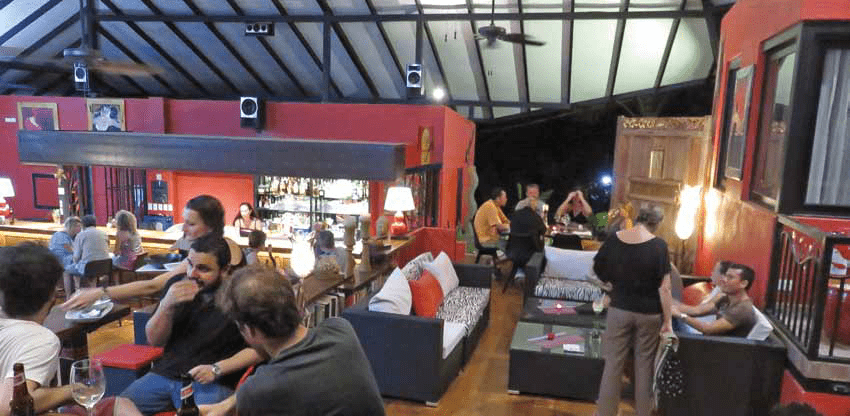
The Poisonous Granular Frog
AUTHOR: Josue Alberto Vargas Montoya (14 years of age)
The spectacular family of poisonous frogs (Dendrobatidae) surprises with its beautiful and colorful and lethal frogs. In Costa Rica, we have eight species of poisonous frogs. Those of the genus "Silverstoneia" and "Allobates" are not harmful.
The genus "Oophaga" is famous for its "pants," and the only two species of Oophaga of Costa Rica (O. Pumilio and O. Granulifera) are those that present pants.
The Granular Poisonous Frog (Oophaga Granulifera) is endemic to the Central Pacific and southern Costa Rica and part of Panama. It can be located near gorges in the woods.
In Costa Ballena, you can find the Red morpho with its green pants and his back "Granular," hence its name.
no images were found
After Hacienda Barú towards the Central Pacific, its main red color changes to Orange for the Matapalo sector, yellow in Portalón, and finally an olive green in San Rafael, Quepos always with its green and sometimes light blue pants.
These frogs are in danger due to the loss of their habitat. It is also exploited by smugglers to sell them as Terrarium pets.
Its venom is neurotoxic and very dangerous. It is not recommended to manipulate animals in freedom, especially the beautiful multicolored frogs.
The dangerous thing would be for the poison to reach a wound, or you would suck it.
Indigenous peoples used the poison of these frogs for hunting, smearing the poison on their arrows. That is why some of them are called "arrowhead frogs or dart frogs" in general (phyllobates).
Granular poisonous frogs are well distributed in Costa Ballena. It is a great attraction for tourists and so of interest for tour guides. Costa Ballena is one of the main places to see the Red Morpho, one of the granular venomous frogs.
They are diurnal, and males are heard singing to attract females to reproduce. The female lays her eggs in leaf ponds in the forest. As the hours pass, the eggs become tadpoles waiting for their father to place them in a bromeliad where they will be safe.
The mother feeds them with infertile eggs until they grow and can find food on their own.

Experiencing this Wondrous Pacific Zone
~ by Jeane BrennanThe rice fields dotting the Osa Peninsula are in the process of being harvested, and trucks hauling tons of palm oil fruit are seen every day heading to the processing plants. Oxen, huge and strong, […]

SUD: An Unconventional Restaurant
~ by Dagmar ReinhardThis place is quite big, well ventilated, has several levels, and is in a very lush garden. There is a lounge, a library, a multipurpose area, and a beautiful bar. You will definitely find your own […]

How to Spend more Time in a Hammock?
~ by Dagmar ReinhardTwo weeks before the Envision Festival, we picked Stephen Brooks up at the venue in Uvita. He was extremely busy coordinating between the different working-groups onsite, and mostly supervising the planting of an ever-growing forest of […]

Imagine Yourself Being “Pure Life!”
~ by John BisnerWhy do Costa Ricans use the term “Pura Vida” so often? The expression has been present in their feelings and language for the last 50 years. For the Ticos, the meaning of “pura vida” is […]

Fresh At The Feria: Salt
~ by Luba NikolayevSalt, the magical ingredient that makes flavors come alive, was once called “White Gold” by the Romans and for good reasons. Every cell in our body needs salt to function, and giving the body […]

Keep your Distance…
by Vet. Fernando Riera S.The skunk is always associated to its penetrating and fetid smell, as well as the Pepe le Pew cartoons, the Casanova skunk from the 1950s. The skunk’s “perfume” is its defense method against predator […]
What to do, Where to eat and Where to stay…
- Activities and Tours
- Whale Watching Tour
- Natural Attractions
- Marino Ballena National Park
- Restaurants
- Hotels and Accommodations
Looking for business directories, maps or other printouts? We’ve got that too!
- Tide Charts
- Bus Schedules
- Dominical Business Directory
- Uvita Business Directory
- Costa Ballena Map
- Dominical map
- Uvita map
- Ojochal map
South Pacific Costa Rica Beaches
Dare to Discover and Enjoy…
Check out…
Need help planning your next trip? Let us help you with your Costa Rica vacations!
Email: carlos@ballenatales.com
Phone: +(506) 8946 7134 or +(506) 8914 1568
